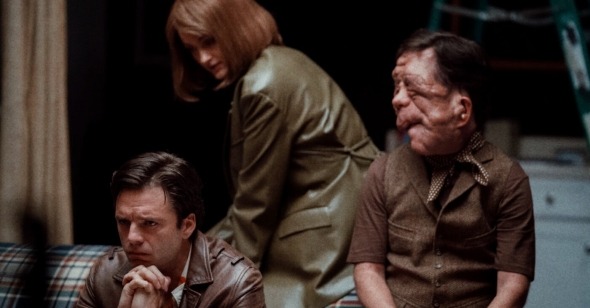Another Round
by Dan Schindel
A Different Man
Dir. Aaron Schimberg, U.S., A24
In Aaron Schimberg’s 2019 feature Chained for Life, a coterie of actors cast as stereotypical “freaks” in a Euro-exploitation production enact a small rebellion by shooting their own movie after-hours. The lines between the film itself and the films within it continually blur and a relationship develops between the conventionally attractive blonde lead and a man who, like his portrayer Adam Pearson, has neurofibromatosis. Now, in A Different Man, Schimberg has furthered his incisive dissection of the cinematic representation of disfigurement and disability.
Pearson, Schimberg’s partner in this ongoing project, returns as a lead in A Different Man. It’s a genuinely distinct role for a physically different performer, one in which he not only gets to be effortlessly charming but even plays the Chad to another character’s Beta. He’s Oswald, preternaturally good at anything he tries—karaoke, yoga, stage acting—and the perpetual frenemy of Sebastian Stan’s Guy, who, despite his good looks, is plagued by insecurity and envies Oswald’s social grace. Pearson flourishes here, almost parodically amiable but genuinely likable, emblemizing the film’s tricky tonal balancing act.
Guy and Oswald meet in the back half of the film, after Guy has undergone a significant transformation. For the first act, Stan wears a complicated (and, in a tribute to makeup designer Mike Marino’s talent, quite convincing) facial prosthetic. Here, he’s Edward, who like Oswald has neurofibromatosis, and the condition weighs on him psychically as much as the prosthetic seems to smother Stan. He’s an aspiring actor who can’t get work as anything besides an object lesson in a corporate PSA about being professional to one’s “different-looking” co-workers. His new neighbor, playwright Ingrid (Renate Reinsve), shows him tentative kindness, and he seizes on the gesture in the hopes of romance, only for that prospect to get shot down. When an experimental treatment becomes available, Edward eagerly signs up, inciting a gruesome, literally face-melting metamorphosis that feels much more authentically Cronenbergian than any of that director’s myriad contemporary imitators like Ducornau or Fargeat (to say nothing of his own children). Now bearing Stan’s actual visage, Edward fakes his death, rechristens himself “Guy,” and starts a new life.
Like John Frankenheimer’s Seconds (1966), A Different Man is pitiless in dramatizing how much its protagonist can’t get away from himself. Just as John Randolph’s unfulfilled banker couldn’t find spiritual satisfaction in becoming an artist played by Rock Hudson, Stan affects himself as if he’s wearing that tumorous mask even after he’s had his makeover. He shrinks from those around him, evincing the perpetual wariness of a wounded animal. He collides with Oswald when Ingrid mounts a stage show inspired by her erstwhile neighbor. Chained for Life’s withering satirizing of cinema’s historical treatment of the physical other is recalled in the cloying snippets of the play-within-the-film. Ingrid recreates multiple moments from her relationship with Edward, but where she never did more than keep him at a friendly arm’s length, on stage the character based on her is hanging on his every word, learning life lessons from his saintly example. In case there’s any doubt about her feelings toward the real Edward, when Guy asks about a typewriter he gifted her, she can’t recall where it came from. The depiction of the self-satisfied, hollow progressivism that can be found Off-Off-Broadway is as accurate as a laser and burns just as harshly.
Guy, who has left behind acting for the kind of office environment seen in the PSAs in which he once appeared, is compelled to audition for the show. How could he not be? He has a chance to relive his relationship with Ingrid in a charged, romanticized mode. Enter Oswald. Guy already has the role (and wears a rubber mask during rehearsals), but he would seem a much more natural fit, since he actually has Edward’s condition. Many conversations ensue around the appropriateness of casting for authenticity, resulting in a dizzyingly complicated metafictional riff on the politics and discourse of representation.
That’s of a piece with A Different Man’s broader tactics of disorientation. Guy/Edward’s surroundings seem to mirror the malaise in his psyche. Edward’s apartment is dank and cramped, with a growing mold stain in the ceiling acting as one of the film’s more obvious metaphors. When he becomes Guy, he moves into a soulless white loft, the surfeit of sunlight bringing no joy, instead sterilizing everything. When Ingrid and Oswald move into his former apartment, they renovate it and make it beautiful, warmly lit, and tastefully decorated, again reinforcing how Guy/Edward’s woes are self-inflicted. As he watches how easily Oswald navigates the world despite his condition, the horrible question persists: All along, was his actual problem his personality? You can’t take pills for that.
